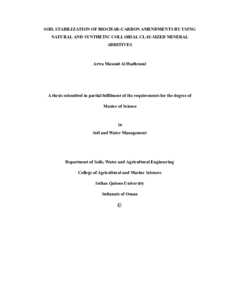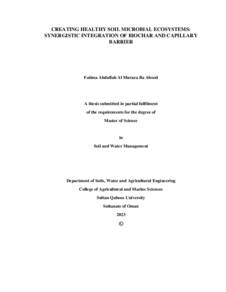Document
Soil stabilization of biochar-carbon amendments by using natural and synthetic colloidal clay sized minerals additives.
Source
Master's thesis
Other titles
تثبيت إضافات الفحم الحيوي في التربة باستخدام معادن بحجم الطين الغرواني الطبيعي والاصطناعي
Country
Oman
City
Muscat
Publisher
Sultan Qaboos University
Gregorian
2023
Language
English
Thesis Type
Master's thesis
English abstract
Biochar is a carbon-rich material used to increase the fertility of the soil and improve its
properties. It is produced through a process called pyrolysis which determines its stability.
Biochar produced at low temperatures is known to have a lower half-life compared to those
produced at higher temperatures. In this study, we investigated the effect of different clay
co-amendments on biochar stability as measured through microbial respiration (cumulative
CO2 production during the first month of incubation in soils). The effect on microbial
enumeration, activity, and diversity was also assayed. We hypothesized that a) the biochar
treated with inorganic clays increase biochar stability and reduce its degradation rate in
calcareous sandy soils of Oman, and b) based on the available literature, allophane clays
would be the most effective biochar additive for this purpose. Local clays were also tested
as a sustainable alternative to Allophane and Ferrihydrite synthetic clays and were
separated from the Al Khoud dam sediment after flocculation with Fe, Mg, Ca and HCl.
Biochar clay homogenous mixtures were achieved in stirred suspensions at different doses
(0, 0.032, 0.064, 0.128, 0.256, and 0.512) % by mass. Biochar that was obtained from date
palm leaves was pyrolyzed at 450 °C and applied to the soil at 2.5% by weight. The results
showed that biochar increased the soil microbial respiration rate, and the addition of
different clays to biochar showed a stabilization effect bringing respiration rates closer to
unamended soils. In general, the clays significantly reduced the average respiration rate
except for soil biochar with local clays coated with calcium (SB-cCa) and soil biochar with
local clays treated with hydrochloric acid (SB-cHCl) treatments. Moreover, ferrihydrite
(Fh) at the maximum tested dosage (0.5%) was the most effective treatment to achieve this
effect. The reduction in respiration rate was not reflected in a reduction in bacterial
enumeration. The 16S rRNA prokaryotic community taxonomic diversity characterization
showed more diversity in control soil compared with treated soils with 2.5% biochar and
0.512% clays and revealed a decreased abundance of archaea in samples amended with
biochar and clays, with an increase in the dominance of firmicutes, especially in SB-cHCl
treated samples. The differences in Shannon and Evenness diversity indexes for total
operational taxonomic units (OTUs) between control soil and soil amended with biochar
and clays were small, while for the class reduced compared with control soil. The addition
of both locally sourced natural clays and synthetic clays caused a strong increase in the
flavobacteriia class. The pH of biochar amendments appears to be driving the abundance
of actinomycetia and betaproteobacteria. These findings highlight the potential of biochar
and clays as effective soil management strategies for enhancing biochar stability and the long-term effect on carbon sequestration and other soil features offering a sustainable
solution for agriculture and ecosystem restoration in arid regions.
Arabic abstract
الفحم الحيوي مادة غنية بالكربون تستخدم لزيادة خصوبة التربة وتحسين خصائصها، يتم إنتاجه من خلال عملية تسمى الانحالل الحراري والتي تحدد ثباته في التربة. الفحم الحيوي المنتج في درجات حرارة منخفضة يتمتع بنصف عمر بتلك المنتجة في درجات حرارة أعلى ً أقل مقارنة . في هذا البحث قمنا بالتحقق من تأثير إضافة معادن مختلفة بحجم الطين الغرواني الطبيعي والاصطناعي على ثبات الفحم الحيوي عن طريق قياس التنفس الميكروبي )للإنتاج التراكمي لثاني أكسيد الكربون خلال الشهر الأول من الحضانة في التربة(. تم أيضا تقييم التأثير اللاحق على تعداد الميكروبات ونشاطها وتنوعها. افترضنا أن أ( تثبيت الفحم الحيوي المعدل بواسطة إضافة الطين غير العضوي سيعزز من استقرار استنادا على الدراسات المنشورة، سيكون ً الفحم الحيوي وتقليل معدل تحلله في التربة الرملية الكلسية في عمان، و ب( الطين المستخرج من الالوفان أكثر فعالية كإضافة لتعزيز استقرار الفحم الحيوي لهذا الهدف. تم فحص الطين المحلي كبديل محتمل للطين الصناعي، وقد تم فصله من عينات تربة من رواسب سد الخوض بعد إضافة الحديد، المغنيسيوم، الكالسيوم وحمض الهيدروكلوريك. تم إضافة الانواع المختلفة من معادن الطين الغرواني الطبيعي والاصطناعي بجرعات مختلفة )،0 ،0.032 ،0.064 ،0.128 ،0.256 0.512( ٪ بالكتلة. الفحم الحيوي الذي تم الحصول عليه من أوراق النخيل تم تحليله حراريًا عند 450 درجة مئوية ووضعه على التربة بنسبة 2.5 ٪ من الوزن الكامل. أوضحت النتائج أن الفحم الحيوي أسهم في زيادة معدالت التنفس الميكروبي للتربة. كما أظهرت إضافات مختلفة من معادن تأثيرا في استقراره، مما جعل معدالت التنفس الميكروبي ً الطين—سواء الطبيعية أو الصناعية—إلى الفحم الحيوي أقرب إلى التربة غير المعدلة. بشكل عام، خفضت معادن الطين الغرواني الطبيعي والاصطناعي المستخدمة بشكل كبير متوسط معدل التنفس الميكروبي باستثناء تلك المعالجة بالكالسيوم وحمض الهيدروكلوريك. عالوة على ذلك، كان الفيريهايدرات (Fh (المصنع في المختبر هو للإضافة الأكثر فعالية لتحقيق هذا التأثير عند الحد الاقصى للجرعة المختبرة )٪0.5(، ولم ينعكس انخفاض معدل التنفس في انخفاض تعداد البكتيريا. بالاضافة الى ذلك، أظهر توصيف التنوع التصنيفي المجتمعي بدائية النواة مزيدا من التنوع الميكروبي في التربة الغير معالجة مقارنة بتلك المعالجة بالفحم الحيوي والطين، كما أنه كشف عن انخفاض في وفرة العتائق في العينات المعدلة بالفحم الحيوي والطين وزيادة في هيمنة )Firmicutes (خاصة في العينات المعالجة بحمض الهيدروكلوريك. كانت الاختالفات في مؤشرات تنوع شانون (Shannon (والتساوي إلجمالي وحدات التصنيف التشغيلية (OTUs (بين التربة غير المعدلة والتربة المعدلة بالفحم ً الحيوي والطين صغيرة، بينما انخفضت في الفئة (Class( مقارنة بالتربة غير المعدلة. أدت إضافة كال من الطين الطبيعي من مصادر محلية والطين الاصطناعي إلى زيادة قوية في فئة البكتيريا المعروفة ب flavobacteria. كما أظهرت النتائج أن الرقم الهيدروجيني للفحم الحيوي يقود وفرة كال من actinomycetia وbetaproteobacteria. تسلط هذه النتائج الضوء على إمكانات الفحم الحيوي والطين كاستراتيجيات فعالة إلدارة التربة لتعزيز استقرار الفحم الحيوي والتأثير طويل المدى على عزل الكربون وميزات التربة الاخرى التي تقدم حالً مستدا ًما للزراعة واستعادة النظام البيئي في المناطق الجافة.
Category
Theses and Dissertations


